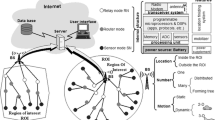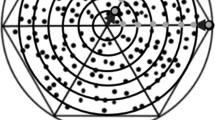Abstract
This work proposes an approach for improving energy-efficiency and thus increasing network lifetime in wireless sensor network (WSN) using a logical energy tree (LET). In our scheme, LET is constructed using the remaining available energy in each node. Two routing algorithms are framed based on LET: one with centralized sink node called LETCSN and the other with centralized sink node and secondary sink nodes called LETSSN. sensor nodes are deployed in some fixed patterns. A mathematical model is devised to understand the effect of node deployment pattern on improving network lifetime. Both proposed routing algorithms are evaluated with seven different deployment patterns, simulated in ns-2 and are compared with the existing classic algorithms based on the number of data packets, throughput, network lifetime, and data packet’s average network lifetime product. Our evaluation and simulation results show that LETSSN maximizes the network lifetime for all node-deployment patterns taken into consideration.









Similar content being viewed by others
Notes
The term ‘Data’ is considered plural. Singular is ‘Datum’.
The terms ‘deployment’ and ‘distribution’ are used interchangeably throughout the work.
References
Liu, X. (2012). A survey on clustering routing protocols in wireless sensor networks. Sensors (Basel)., 12(8), 11113–53. doi:10.3390/s120811113.
Al-Karaki, J. N., & Kamal, A. E. (2004). Routing techniques in wireless sensor networks: A survey. IEEE Wireless Communications, 11(6), 6–28.
Alippi, C., Anastasi, G., Di Francesco, M., & Roveri, M. (2009). Energy management in wireless sensor networks with energy-hungry sensors. IEEE Instrumentation & Measurement Magazine, 12(2), 16–23.
Nikolidakis, S. A., Kandris, D., Vergados, D. D., & Douligeris, C. (2013). Energy efficient routing in wireless sensor networks through balanced clustering. Algorithms, 6(1), 29–42. doi:10.3390/a6010029.
Sen, F., Bing, Q., & Liangrui, T. (2011). An improved energy-efficient PEGASIS based protocol in wireless sensor networks. In 2011 Eighth International Conference on Fuzzy Systems and Knowledge Discovery (FSKD), Volume: 4, pp. 2230–2233.
Pathan, A.-S. K., & Hong, C. S. (2008). SERP: Secure energy-efficient routing protocol for densely deployed wireless sensor networks. Annals of Telecommunications, 63, 529–541. doi:10.1007/s12243-008-0042-5.
The Network Simulator—ns-2: http://www.isi.edu/nsnam/ns/.
Pantazis, N. A., Nikolidakis, S. A., & Vergados, D. D. (2013). Energy-efficient routing protocols in wireless sensor networks: A survey. IEEE Communications Surveys & Tutorials, 15(2), 551–591. Second Quarter.
Li, C., Zhang, H., Hao, B., & Li, J. (2011). A survey on routing protocols for large-scale wireless sensor networks. Sensors, 11, 3498–3526. doi:10.3390/s110403498.
Zin, S. M., Anuar, N. B., Kiah, M. L. M., & Pathan, A.-S. K. (2014). Routing protocol design for secure WSN: Review and open research issues. Journal of Network and Computer Applications, 41, 517–530. doi:10.1016/j.jnca.2014.02.008. Elsevier.
Heinzelman, W. R., Chandrakasan, A., & Balakrishnan, H. (2000). Energy-efficient communication protocol for wireless microsensor networks. In Proceedings of the 33rd Annual Hawaii International Conference on System Sciences. doi:10.1109/HICSS.2000.926982.
Koucheryavy, A., Salim, A., & Osamy, W. (2009). Enhanced LEACH protocol for wireless sensor networks. St. Petersburg University of Telecommunication. http://www.iot.sut.ru/09.pdf. Last accessed 6 May 2014.
Li, B., & Zhang, X. (2012). Research and improvement of LEACH protocol for wireless sensor network. In International Conference on Information Engineering, Lecture Notes in Information Technology, vol. 25.
Iqbal, A., Akbar, M., Javaid, N., Bouk, S. H., Ilahi, M., & Khan, R. D. (2013). Advanced LEACH: A static clustering-based heteroneous routing protocol for WSNs. Journal of Basic Appllied Science and Research, 3(5), 864–872.
Qing, L., Zhu, Q., & Wang, M. (2006). Design of a distributed energy-efficient clustering algorithm for heterogeneous wireless sensor networks. Computer Communications, 29(12), 2230–2237.
Lindsey, S., & Raghavendra, C. S. (2002). PEGASIS: Power-efficient gathering in sensor information systems. IEEE Aerospace Conference Proceedings, 3, 1125–1130.
Lindsey, S., Raghavendra, C. S., & Sivalingam, K. (2000). Data gathering in sensor networks using the energy*delay metric. In Proceedings 15th International Parallel and Distributed Processing Symposium., 23–27, San Francisco, CA, USA, pp. 2001–2008.
Manjeshwar, A., & Agrawal, D. P. (2000). TEEN: A routing protocol for enhanced efficiency in wireless sensor networks. In Proceedings 15th International Parallel and Distributed Processing Symposium., 23–27, San Francisco, CA, USA, pp. 2009–2015.
Xu, Z., Yin, Y., Wang, J., & Kim, J.-U. (2012). An energy-efficient multi-sink clustering algorithm for wireless sensor networks. International Journal of Control and Automation, 5(4), 131–142.
Huang, Z., Cheng, Y., & Liu, W. (2011). A Novel energy-efficient routing algorithm in multi-sink wireless sensor networks. In 2011 IEEE 10th International Conference on Trust, Security and Privacy in Computing and Communications (TrustCom), 16–18 Nov. pp. 1646–1651.
Carels, D., Derdaele, N., Poorter, E. D., Vandenberghe, W., Moerman, I., & Demeester, P. (2014). Support of multiple sinks via a virtual root for the RPL routing protocol. EURASIP Journal on Wireless Communications and Networking, 2014, 91. doi:10.1186/1687-1499-2014-91.
Natalizio, E., Loscri, V., & Viterbo, E. (2008). Optimal placement of wireless nodes for maximizing path lifetime. IEEE Communications Letters, 12(5), 362–364.
Lim, J. C., & Bleakley, C. (2012). Adaptive WSN scheduling for lifetime extension in environmental monitoring applications. International Journal of Distributed Sensor Networks, 2012. Article ID 286981, p. 17. doi:10.1155/2012/286981.
Li, Q.-Q., Gong, H., Liu, M., Yang, M., & Zheng, J. (2011). On prolonging network lifetime through load-similar node deployment in wireless sensor networks. Sensors (Basel), 11(4), 3527–3544. doi:10.3390/s110403527.
Li, J., & AlRegib, G. (2009). Network lifetime maximization for estimation in multihop wireless sensor networks. IEEE Transactions on Signal Processing, 57(7), 2456–2466.
Sullivan III, M. (2010). Fundamentals of statistics. 3rd Edn, Sullivan Statistics Series, Pearson, ISBN-13: 978-0321641878, Jan 13.
Mamun, Q. (2012). A qualitative comparison of different logical topologies for wireless sensor networks. Sensors, 12(11), 14887–14913. doi:10.3390/s121114887.
Slama, I., Jouaber, B., & Zeghlache, D. (2010). Topology control and routing in large scale wireless sensor networks. Wireless Sensor Network, Scientific Research, 2, 584–598.
Das, D., Rehena, Z., Roy, S., & Mukherjee, N. (2013). Multiple-sink placement strategies in wireless sensor networks. In 2013 Fifth International Conference on Communication Systems and Networks (COMSNETS), pp. 1–7.
Oyman, E. I., & Ersoy, C. (2004) Multiple sink network design problem in large scale wireless sensor networks. In 2004 IEEE International Conference on Communications, vol 6, 20–24 June, pp. 3663–3667.
Lecture handout on graph theory. http://www.cs.cmu.edu/afs/cs/academic/class/15251/Site/current/Materials/Handouts/lecture20-proofs.pdf. Last accessed 9 May 2014.
Radi, M., Dezfouli, B., Bakar, K. A., & Razak, S. A. Integration and analysis of neighbor discovery and link quality estimation in wireless sensor networks. The Scientific World Journal, 2014, 23. (Article ID 789642)
Author information
Authors and Affiliations
Corresponding author
Rights and permissions
About this article
Cite this article
Murugan, K., Pathan, AS.K. Prolonging the lifetime of wireless sensor networks using secondary sink nodes. Telecommun Syst 62, 347–361 (2016). https://doi.org/10.1007/s11235-015-0079-5
Published:
Issue Date:
DOI: https://doi.org/10.1007/s11235-015-0079-5




